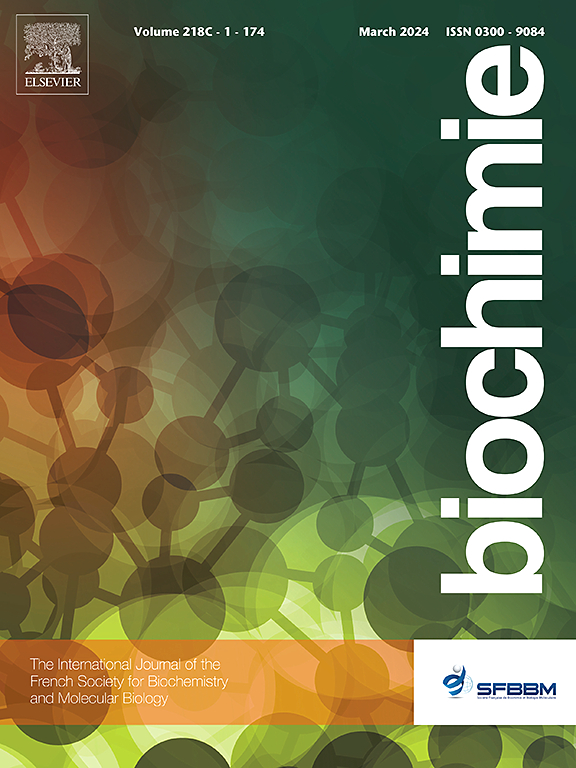A new isoxazolyl-urea derivative induces apoptosis, paraptosis, and ferroptosis by modulating MAPKs in pancreatic cancer cells
IF 3.3
3区 生物学
Q2 BIOCHEMISTRY & MOLECULAR BIOLOGY
引用次数: 0
Abstract
MAPK pathway regulates the major events including cell division, cell death, migration, invasion, and angiogenesis. Small molecules that modulate the MAPK pathway have been demonstrated to impart cytotoxicity in cancer cells. Herein, the synthesis of a new isoxazolyl-urea derivative (QR-4) has been described and its effect on the growth of pancreatic cancer cells has been investigated. QR-4 reduced the cell viability in a panel of pancreatic cancer cells with minimal effect on normal hepatocytes. QR-4 induced the cleavage of PARP and procaspase-3, reduced the expression of antiapoptotic proteins, increased SubG1 cells, and annexin V/PI-stained cells indicating the induction of apoptosis. QR-4 also triggered paraptosis as witnessed by the reduction of mitochondrial membrane potential, decrease in the expression of Alix, increase in the levels of ATF4 and CHOP, and enhanced ER stress. QR-4 also modulated ferroptosis-related events such as elevation in iron levels, alteration in GSH/GSSG ratio, and increase in the expression of TFRC with a parallel decrease in the expression of GPX4 and SLC7A11. The mechanistic approach revealed that QR-4 increases the phosphorylation of all three forms of MAPKs (JNK, p38, and ERK). Independent application of specific inhibitors of these MAPKs resulted in a partial reversal of QR-4-induced effects. Overall, these reports suggest that a new isoxazolyl-urea imparts cell death via apoptosis, paraptosis, and ferroptosis by regulating the MAPK pathway in pancreatic cancer cells.
一种新的异噁唑基脲衍生物通过调节胰腺癌细胞中的 MAPKs,诱导细胞凋亡、副凋亡和铁凋亡。
MAPK 通路调节细胞分裂、细胞死亡、迁移、侵袭和血管生成等主要事件。调节 MAPK 通路的小分子已被证明对癌细胞具有细胞毒性。本文介绍了一种新的异噁唑基脲衍生物(QR-4)的合成,并研究了它对胰腺癌细胞生长的影响。QR-4 降低了一组胰腺癌细胞的存活率,而对正常肝细胞的影响极小。QR-4 可诱导 PARP 和 procaspase-3 的裂解,减少抗凋亡蛋白的表达,增加 SubG1 细胞和附件素 V/PI 染色的细胞,这表明 QR-4 可诱导细胞凋亡。QR-4 还能触发凋亡,表现为线粒体膜电位降低、Alix 表达减少、ATF4 和 CHOP 水平升高以及 ER 应激增强。QR-4 还调节了铁跃迁相关事件,如铁水平升高、GSH/GSSG 比率改变、TFRC 表达增加,同时 GPX4 和 SLC7A11 表达减少。机理研究表明,QR-4 会增加所有三种形式的 MAPK(JNK、p38 和 ERK)的磷酸化。独立应用这些 MAPKs 的特异性抑制剂可部分逆转 QR-4 诱导的效应。总之,这些报告表明,一种新的异噁唑基脲通过调节胰腺癌细胞的 MAPK 通路,使细胞通过凋亡、副凋亡和铁凋亡而死亡。
本文章由计算机程序翻译,如有差异,请以英文原文为准。
求助全文
约1分钟内获得全文
求助全文
来源期刊

Biochimie
生物-生化与分子生物学
CiteScore
7.20
自引率
2.60%
发文量
219
审稿时长
40 days
期刊介绍:
Biochimie publishes original research articles, short communications, review articles, graphical reviews, mini-reviews, and hypotheses in the broad areas of biology, including biochemistry, enzymology, molecular and cell biology, metabolic regulation, genetics, immunology, microbiology, structural biology, genomics, proteomics, and molecular mechanisms of disease. Biochimie publishes exclusively in English.
Articles are subject to peer review, and must satisfy the requirements of originality, high scientific integrity and general interest to a broad range of readers. Submissions that are judged to be of sound scientific and technical quality but do not fully satisfy the requirements for publication in Biochimie may benefit from a transfer service to a more suitable journal within the same subject area.
 求助内容:
求助内容: 应助结果提醒方式:
应助结果提醒方式:


